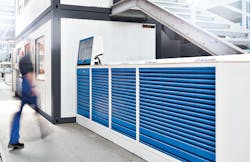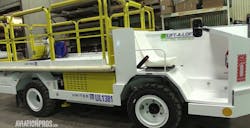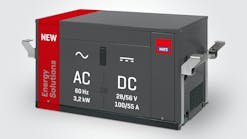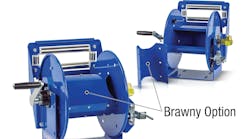Getting Tools Out to Employees Quicker
Tools from automatic issuing machines – this is already common practice in some maintenance workshops. Consequently, employees have round-the-clock access to tools and personal protective work wear. Shortages can also be avoided thanks to automatic reordering.
Traditional tool stores have now been consigned to the history books in some maintenance workshops. Modern goods issuing systems have popped up in their place, giving workers 24-hour access to tools and personal protective work wear and keeping track of current stocks. A log-in system for workers means that equipment required for individual projects can be sorted before a drawer or issuing compartment opens.
Always in stock
Keeping the issuing system fully stocked with enough tools and protective work wear is obviously a priority. That is why modern tool management systems share information with the management software or the workshop's materials management system, automatically notifying purchasing and planning departments and placing new orders if numbers fall below minimum quantities. For workshops where multiple tool issuing systems are used, it is also important that all machines can be connected to a central control unit and operated in parallel. This should also be a consideration for smaller operations if they are toying with the idea of using a system like this. Setting up multiple systems at different locations can often pay for itself by shortening the time it takes to fetch equipment.
The DB Fahrzeuginstandhaltung GmbH plant in Neumünster, for example, benefits from the advantages of a fully automated tool issuing system. The works management wanted to ensure that the 500-strong workforce had round-the-clock easy access to the tools they needed across all 3 shifts. They also wanted to significantly reduce the time spent fetching tools. This difficulty arises because there are various workshops across the site, so fetching tools may at times take longer and be more time-consuming. Using the GARANT Tool24 Smartline goods issuing system has allowed the company not only to improve its operations through reduced times for fetching tools and through continuous round-the-clock availability of tools; it has also significantly raised the job satisfaction of the employees. The system simplifies employees’ access to tools – especially during the night shift when the normal tool stores are no longer staffed. Employees can serve themselves from the sturdy cabinets with up to 90 drawers. In addition, employees can quickly identify the equipment that they require thanks to the intuitive software search facility by scanner, key word search or item number.
Built according to the modular design principle
An issuing system can be used particularly economically if it can fit as much inside it as possible. For this reason, with the GARANT Tool24 Smartline goods issuing system, the customer can choose drawers with differing heights and widths. The GARANT Tool24 PickOne offers an individual output system with four different combinable compartments in line with the modular principle to organise the individual output of selected C-articles. Individual output allows for an especially high level of control over consumable materials because after an employee has logged on to the system, they only have limited access to individual items because of the small withdrawal compartments. Even the stock levels of classic C-articles can be monitored precisely. For instance, individual issuing makes it possible to reduce the wastage of safety gloves or earplugs by up to 50 percent. This has been the experience of customers of the Hoffmann Group. If heavy articles must be managed by the individual output system, the system also needs to be able to hold particularly heavy loads. Some tool management systems have been designed for this reason to hold load capacities of up to a tonne.
Modern tool issuing systems aren’t just robust and reliable, though. They are also extremely intelligent as they are controlled by intricately programmed software. Because they already know and can be optimally informed about tool requirements and tool usage, they certainly have the potential to become the central hub for tool data and represent an important step on the way to implementing Industry 4.0 strategies.





